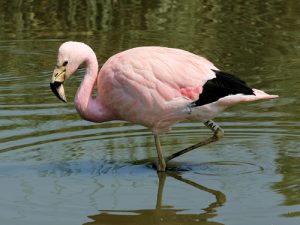Latest update March 25th, 2025 7:08 AM
Latest News
- Surinamese invest US$516M into country’s first oil project
- ExxonMobil impact study for Hammerhead project silent on likely explosion from new pipeline
- ‘A shocking breach’: Trump officials leak military attacks to The Atlantic
- Pensioner goes missing during creek outing at Kwakwani
- Cuban national jailed for entering Guyana illegally
Interesting Creatures… The Chilean flamingo (Phoenicopterus chilensis)
Jul 31, 2016 Features / Columnists, Interesting Creatures in Guyana
 The Chilean flamingo (Phoenicopterus chilensis) is a large species of flamingo at 110–130 cm (43–51 in) closely related to American flamingo and greater flamingo, with which it was sometimes considered conspecific. The species is listed as Near Threatened by the IUCN.
The Chilean flamingo (Phoenicopterus chilensis) is a large species of flamingo at 110–130 cm (43–51 in) closely related to American flamingo and greater flamingo, with which it was sometimes considered conspecific. The species is listed as Near Threatened by the IUCN.
It breeds in South America from Ecuador and Peru to Chile and Argentina and east to Brazil; it has been introduced into Germany and the Netherlands (colony on the border, Zwillbrocker Venn). There was also a small population in Utah and California. Like all flamingos it lays a single chalky white egg on a mud mound.
The plumage is pinker than the slightly larger greater flamingo, but less so than Caribbean flamingo. It can be differentiated from these species by its greyish legs with pink joints (tibio-tarsal articulation), and also by the larger amount of black on the bill (more than half). Young chicks may have no sign of pink colouring whatsoever, but instead remain grey.
The Chilean flamingo’s bill is equipped with comb-like structures that enable it to filter food—mainly algae and plankton—from the water of the coastal mudflats, estuaries, lagoons and salt lakes where it lives.
Chilean flamingos live in large flocks in the wild and require crowded conditions to stimulate breeding. During breeding season, males and females display a variety of behaviors to attract mates, including head flagging—swiveling their heads from side-to-side in tandem—and wing salutes, where the wings are repeatedly opened and closed. Males and females cooperate in building a pillar-shaped mud nest, and both incubate the egg laid by the female. Upon birth, the chicks have grey plumage; they don’t gain adult coloration for two-three years. Both male and female flamingos can produce a nutritious milk-like substance in their crop gland to feed their young.
The first flamingo hatched in a European zoo was a Chilean flamingo at Zoo Basel (Switzerland) in 1958.
In 1988, a Chilean Flamingo that lived in the Tracy Aviary had mistakenly not received his routine wing clipping. The flamingo escaped, and became a local legend in the Greater Salt Lake area known as ‘Pink Floyd the Flamingo’. Pink Floyd flew to Utah in the winters to eat the brine shrimp that lived in the Great Salt Lake and flew north to Idaho and Montana in the spring and summer. Pink Floyd became a popular tourist attraction and local icon until his disappearance and presumed death after he flew north to Idaho one spring in 2005 and was never heard from again. (Source: Wikipedia)
Share this:
- Click to print (Opens in new window)
- Click to email a link to a friend (Opens in new window)
- Click to share on Facebook (Opens in new window)
- Click to share on WhatsApp (Opens in new window)
- Click to share on Twitter (Opens in new window)
- Click to share on Pinterest (Opens in new window)
- Click to share on Pocket (Opens in new window)
- Click to share on Tumblr (Opens in new window)
- Click to share on Reddit (Opens in new window)
- Click to share on LinkedIn (Opens in new window)
Related
Similar Articles

The Glenn Lall Show|| March, 17th, 2025
Follow on Tik Tok @Glennlall
THE BLUNT OF THE DAY

Sports
Mar 25, 2025
Kaieteur Sports- With just 11 days to go before Guyana welcomes 16 nations for the largest 3×3 basketball event ever hosted in the English-speaking Caribbean, excitement is building. The Guyana...Features/Columnists
Desecration, Disrespectful, and Disgraceful
Peeping Tom… Kaieteur News- The solemnity of Babu Jaan, a site meant to commemorate the life and legacy of Dr. Cheddi... more
The Caribbean: Destined to Grin and Bear the Consequences of Its Self-Created Vulnerabilities?
By Sir Ronald Sanders For decades, many Caribbean nations have grappled with dependence on a small number of powerful countries... more
Publisher’s Note
Freedom of speech is our core value at Kaieteur News. If the letter/e-mail you sent was not published, and you believe that its contents were not libellous, let us know, please contact us by phone or email.
Feel free to send us your comments and/or criticisms.
Contact: 624-6456; 225-8452; 225-8458; 225-8463; 225-8465; 225-8473 or 225-8491.
Or by Email: [email protected] / [email protected]
Weekend Cartoon














